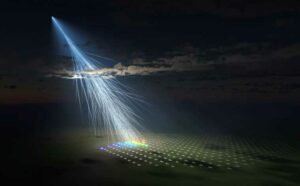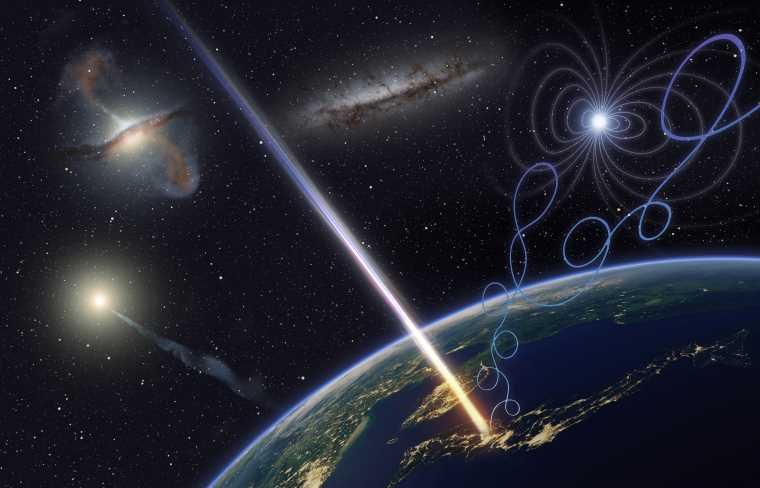Astronomers operating the Telescope Array Collaboration project, based in Utah, say they have detected an ultra-high-energy cosmic ray (UHECR) with no discernible origin. Instead, the extremely rare cosmic event appears to originate from a virtually empty void in space, leaving the researchers completely baffled.
“The findings show that its arrival direction shows no obvious source galaxy, or any other known astronomical objects thought to be potential sources of UHECRs,” they explain. “Instead, its arrival direction points back to void in the large-scale structure of the Universe – a region where very few galaxies reside.”
Many Theories, No Consensus for Rare Cosmic Phenomenon
Astronomers detect cosmic rays all the time. Classified as “low energy” cosmic rays, this steady stream of particles emitted by the sun is recorded by telescopes as energetic “noise.” In contrast, ultra-high energy cosmic ray detections are an extremely rare phenomenon whose origins remain an unsolved mystery.
“The origins of rarer UHECRs are thought to be related to the most energetic phenomena in the Universe, such as those involving black holes, gamma-ray bursts, and active galactic nuclei,” the researchers explain. “Yet much about the physics and acceleration mechanisms of these particles remains unknown.”
These cosmic events are also extremely rare, with the researchers behind this latest find saying that UHECR detections occur less than one particle per century per square kilometer. Fortunately, the Telescope Array in Utah has an “effective detection” of 700 square kilometers, increasing their odds of making such a detection.
Now, that mystery seems to be growing deeper, with this latest UHECR detection seemingly coming from a virtually empty area of space.
Ultra-High Energy Cosmic Ray Was Millions of Times More Powerful Than Human-Made Particle Accelerators
For a cosmic ray to be classified as a UHECR, its energy must exceed one exa-electron volt (Eev). This is a million times the energy reached by the most powerful human-made particle accelerators.
This particular detection, which was made on May 27, 2021, showed a “calculated energy” of about 244 EeV. Such a powerful cosmic ray, one they have since named “Amaterasu” in honor of the Shinto sun god, would rival some of the most powerful UHECRs ever observed, second only to the “Oh-My-God” particle discovered in 1991 that packed a whopping 320 Eev.


“When I first discovered this ultra-high-energy cosmic ray, I thought there must have been a mistake, as it showed an energy level unprecedented in the last three decades,” said the study’s leader, Associate Professor Toshihiro Fujii from the Graduate School of Science and Nambu Yoichiro Institute of Theoretical and Experimental Physics at Osaka Metropolitan University.
Notably, the international team of researchers says such a powerful UHECR should only experience minor deflections from its source and that its arrival direction “should be expected to be more closely correlated to its source.” In short, this meant they should have been able to track the path of the cosmic ray back to where it came from. But when the research team conducted their search, they found only empty space, leaving them completely baffled.
“No promising astronomical object matching the direction from which the cosmic ray arrived has been identified, suggesting possibilities of unknown astronomical phenomena and novel physical origins beyond the Standard Model,” said Fujii.
Mysterious Origin of UHECR Could Challenge Current Theories of Particle Physics
Published in the journal Science, the research study outlining the unique finding says that the mysterious origins of Amaterasu are not only unexpected but directly challenge current theories behind ultra-high-energy cosmic ray origins and behavior.
“This could indicate a much larger magnetic deflection than is predicted by galactic magnetic field models, an unidentified source in the local extragalactic neighborhood, or an incomplete understanding of the associated high-energy particle physics,” they explain.
Nonetheless, Fujii says the Telescope Array Collaboration astronomers are undaunted and will continue to use the best tools available to try to unravel this cosmic mystery.
“In the future, we commit to continue operating the Telescope Array experiment,” said Fujii, “as we embark, through our ongoing upgraded experiment with fourfold sensitivities, dubbed TAx4, and next-generation observatories, on a more detailed investigation into the source of this extremely energetic particle.”
Christopher Plain is a Science Fiction and Fantasy novelist and Head Science Writer at The Debrief. Follow and connect with him on X, learn about his books at plainfiction.com, or email him directly at christopher@thedebrief.org.

